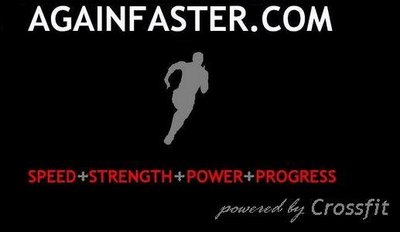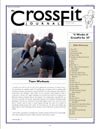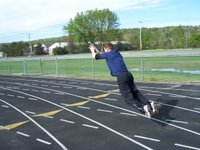Time Under Tension

I've done kettlebell swings before. Badly. Picking up a 24 kg (1.5 pood) kettlebell and swinging it used to rip me right off my feet. I'd end up with back pain and a bruised ego. Clearly, this is no way to go through workouts.
Mandla knows this.
Mandla Nkosi is the principal of Boston Kettlebell. He trains his clients at the Crossfit Boston facility on Terrace Street. His teaching ability is superb, as are his methods.
The first time I saw Mandla, he was swinging two 32 kg (2 pood) kettlebells at the same time. I said three words to him that day.
"Dude, that's nasty."
He just smiled and nodded.
Try grabbing 140 pounds and swinging it. On second thought, don't. You'll just embarrass yourself.
Yesterday evening, Mandla showed me and Sammy the right way to go about swinging iron. Our lesson started with a few two-handed swings of the 16 kg (1 pood) bell. Shoulders retracted, backs arched, we attempted to pop our hips to create momentum on the kettlebell. This is hard if you're doing it the wrong way.
I was doing it the wrong way.
Mandla started at square one, teaching us to build a proper swing from the ground up. We'd learn a portion of the swing and then swing again, incorporating what we had just practiced.
First, we took off our shoes and used our toes to grip the floor. Try it. Take off your shoe, and make a fist with your foot. Rotate your knee outward to "screw" your foot into the ground. Feels pretty solid, doesn't it?
This small action is possibly the most important part of a successful swing. The tension in the feet radiates up the legs, causing the hamstrings and the glutes to contract. This creates an extremely stable base to swing from. A few practice swings, and I was no longer coming off my feet.
The tilt of the pelvis during the kettlebell swing is dynamic. In the bottom position, the pelvis is anteriorly tilted, causing the back to arch (much like a proper squat position). As the athlete extends, the pelvis becomes posteriorly tilted.
The posterior tilt is akin to trying to touch your pelvis to your navel. The glutes flex forcefully, pushing the hips up under the torso. This action activates the rectus abdomenus, creating tension in the core.
In earlier incarnations of my swing, I was not exhibiting dynamic hip action. Instead, I was trying to maintain an arch in my back throughout the movement. There was no transition to a posterior tilt, leading me to come off my feet as I fought the weight for control.
I now had a solid base, a tight core, and a dynamic hip pop. The kettlebell was flying up on the practice swings. This was getting easy.
Next, Mandla taught us to create tension throughout the back. This is helps the athlete control the kettlebell at the top of the swing.
Try this: extend your arms straight out from the shoulder, palms facing downward. Rotate your palms inward slightly, pulling the shoulders backward and down while flexing the lats. If you do this properly, the shoulders should drop slightly, and every muscle in your back will be flexed. This is the feeling you want at the top of a kettlebell swing.
We practiced creating tension in the back by grabbing the pullup bar and performing the movement I just described. Flexing only the shoulders and back, with a death-grip on the bar, we found ourselves halfway into a front lever. From there, we did pullups. It was a great exercise, and a striking demonstration of the efficacy of whole-body tension.
By now, you've noticed that the secret to the kettlebell swing is tension. Creating whole-body tension allows you to maintain control of the kettlebell for the duration of the movement. Without adding an ounce of muscle, you become much more capable of handling heavy weights.
To demonstrate this point, Mandla switched us to one-handed swings. The one-pood bell felt positively light after incorporating his techniques. I couldn't believe how easy it was. The same weight had been pulling me around half-an-hour ago, and I was using two hands!
We did some additional work--squats, half-bridges, and hip mobility drills--all geared toward opening up the hips. This is very important in athletics, as the hips are the primary engine of movement and power generation. Coach Glassman, the founder of Crossfit, contends that efficient power generation from the hips is the hallmark of elite athletes.
The idea of creating tension throughout the body extends beyond kettlebells. It applies to every lift you do. Next time you try a deadlift or a push press, grip the hell out of the bar. Screw your feet into the ground, and tighten every muscle in your torso. You'll become one piece, and you'll move more weight as a result.
My first day at Boston Kettlebell was excellent. I'm convinced that training with Mandla is going to accelerate my Crossfit gains.
In one short hour, he corrected a major weakness in my skill set, and gave me new insight into generating strength and power. There's no way I'm quitting now.
All the way home, Sammy kept repeating:
"That was awesome."
It was.
If you'd like to work with Mandla and Boston Kettlebell, click their icon in the right-hand sidebar, or shoot me an email using the "Contact Again Faster" link. We'll put you in touch.
Go faster!

I've done kettlebell swings before. Badly. Picking up a 24 kg (1.5 pood) kettlebell and swinging it used to rip me right off my feet. I'd end up with back pain and a bruised ego. Clearly, this is no way to go through workouts.
Mandla knows this.
Mandla Nkosi is the principal of Boston Kettlebell. He trains his clients at the Crossfit Boston facility on Terrace Street. His teaching ability is superb, as are his methods.
The first time I saw Mandla, he was swinging two 32 kg (2 pood) kettlebells at the same time. I said three words to him that day.
"Dude, that's nasty."
He just smiled and nodded.
Try grabbing 140 pounds and swinging it. On second thought, don't. You'll just embarrass yourself.
Yesterday evening, Mandla showed me and Sammy the right way to go about swinging iron. Our lesson started with a few two-handed swings of the 16 kg (1 pood) bell. Shoulders retracted, backs arched, we attempted to pop our hips to create momentum on the kettlebell. This is hard if you're doing it the wrong way.
I was doing it the wrong way.
Mandla started at square one, teaching us to build a proper swing from the ground up. We'd learn a portion of the swing and then swing again, incorporating what we had just practiced.
First, we took off our shoes and used our toes to grip the floor. Try it. Take off your shoe, and make a fist with your foot. Rotate your knee outward to "screw" your foot into the ground. Feels pretty solid, doesn't it?
This small action is possibly the most important part of a successful swing. The tension in the feet radiates up the legs, causing the hamstrings and the glutes to contract. This creates an extremely stable base to swing from. A few practice swings, and I was no longer coming off my feet.
The tilt of the pelvis during the kettlebell swing is dynamic. In the bottom position, the pelvis is anteriorly tilted, causing the back to arch (much like a proper squat position). As the athlete extends, the pelvis becomes posteriorly tilted.
The posterior tilt is akin to trying to touch your pelvis to your navel. The glutes flex forcefully, pushing the hips up under the torso. This action activates the rectus abdomenus, creating tension in the core.
In earlier incarnations of my swing, I was not exhibiting dynamic hip action. Instead, I was trying to maintain an arch in my back throughout the movement. There was no transition to a posterior tilt, leading me to come off my feet as I fought the weight for control.
I now had a solid base, a tight core, and a dynamic hip pop. The kettlebell was flying up on the practice swings. This was getting easy.
Next, Mandla taught us to create tension throughout the back. This is helps the athlete control the kettlebell at the top of the swing.
Try this: extend your arms straight out from the shoulder, palms facing downward. Rotate your palms inward slightly, pulling the shoulders backward and down while flexing the lats. If you do this properly, the shoulders should drop slightly, and every muscle in your back will be flexed. This is the feeling you want at the top of a kettlebell swing.
We practiced creating tension in the back by grabbing the pullup bar and performing the movement I just described. Flexing only the shoulders and back, with a death-grip on the bar, we found ourselves halfway into a front lever. From there, we did pullups. It was a great exercise, and a striking demonstration of the efficacy of whole-body tension.
By now, you've noticed that the secret to the kettlebell swing is tension. Creating whole-body tension allows you to maintain control of the kettlebell for the duration of the movement. Without adding an ounce of muscle, you become much more capable of handling heavy weights.
To demonstrate this point, Mandla switched us to one-handed swings. The one-pood bell felt positively light after incorporating his techniques. I couldn't believe how easy it was. The same weight had been pulling me around half-an-hour ago, and I was using two hands!
We did some additional work--squats, half-bridges, and hip mobility drills--all geared toward opening up the hips. This is very important in athletics, as the hips are the primary engine of movement and power generation. Coach Glassman, the founder of Crossfit, contends that efficient power generation from the hips is the hallmark of elite athletes.
The idea of creating tension throughout the body extends beyond kettlebells. It applies to every lift you do. Next time you try a deadlift or a push press, grip the hell out of the bar. Screw your feet into the ground, and tighten every muscle in your torso. You'll become one piece, and you'll move more weight as a result.
My first day at Boston Kettlebell was excellent. I'm convinced that training with Mandla is going to accelerate my Crossfit gains.
In one short hour, he corrected a major weakness in my skill set, and gave me new insight into generating strength and power. There's no way I'm quitting now.
All the way home, Sammy kept repeating:
"That was awesome."
It was.
If you'd like to work with Mandla and Boston Kettlebell, click their icon in the right-hand sidebar, or shoot me an email using the "Contact Again Faster" link. We'll put you in touch.
Go faster!




















0 Comments:
Post a Comment
<< Home